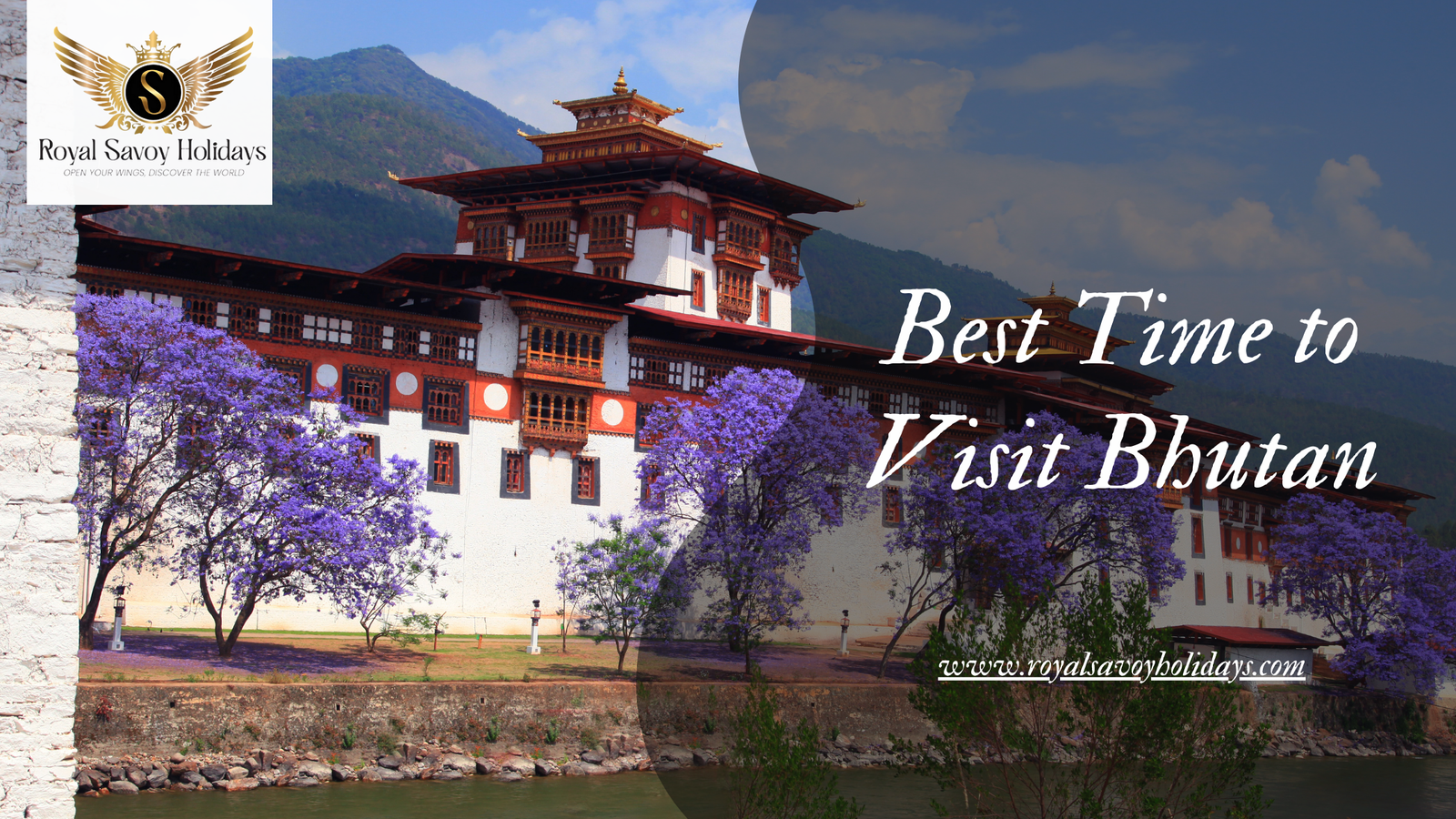Recent Posts
Get In Touch
789 Inner Lane, Holy park, California, USA

Bhutan, the Land of the Thunder Dragon, is a rare destination where natural beauty, spirituality, and culture exist in harmony. Surrounded by the Himalayas, this tiny kingdom offers travelers serene monasteries, vibrant festivals, snow-capped mountains, and lush valleys. But the experience you have depends largely on when you choose to travel.
Some months are perfect for trekking in crisp mountain air, while others are ideal for immersing yourself in Bhutan’s colorful Tsechu festivals. And if you prefer quiet moments in monasteries or birdwatching in pristine valleys, there are seasons that are best suited to you too.
This guide will help you decide the best time to visit Bhutan, season by season, with insights on festivals, weather, activities, and travel tips.
🌸 Spring in Bhutan (March – May): The Season of Blooms
Weather: Spring is pleasantly mild, with daytime temperatures between 15°C to 25°C in valleys. Skies remain clear, making it ideal for sightseeing and photography.
Highlights:
Hillsides and valleys burst into color with blooming rhododendrons, magnolias, and wildflowers.
Trekking trails such as the Druk Path Trek and Jomolhari Trek are at their best, offering clear mountain views and comfortable walking conditions.
Festivals:
The Paro Tsechu (March/April) is one of Bhutan’s biggest festivals. Locals gather in traditional dress, and monks perform mesmerizing mask dances. It’s both a spiritual and cultural extravaganza.
Why Visit in Spring: If you love flowers, photography, and trekking, spring is your season. You’ll experience Bhutan at its most vibrant and colorful.
🌧️ Summer/Monsoon in Bhutan (June – August): The Green Escape
Weather: Warm and humid, with temperatures around 20–27°C. Monsoon showers often arrive in the afternoon or evening, refreshing the landscape.
Highlights:
Valleys turn lush and green, rivers swell, and rice paddies shimmer in the rain.
Because it’s off-season, you’ll encounter fewer tourists—ideal for travelers seeking peace and authentic local interactions.
High-altitude flowers like the blue poppy bloom in summer, a rare sight for nature lovers.
Festivals:
The Haa Summer Festival celebrates nomadic traditions with folk songs, yak races, and local cuisines.
Matsutake Mushroom Festival in Bumthang highlights local delicacies and community spirit.
Why Visit in Summer: This is perfect for budget travelers and those who prefer quiet sightseeing. The landscapes are at their greenest, and cultural festivals in smaller valleys offer unique charm.
🍁 Autumn in Bhutan (September – November): Clear Skies & Cultural Grandeur
Weather: Autumn is the most popular season, with crisp air, pleasant daytime temperatures (15–20°C), and crystal-clear skies. Perfect for trekking and photography.
Highlights:
Best time for treks like the Jomolhari Trek, Druk Path Trek, or even the legendary Snowman Trek.
Himalayan peaks, including Mount Jomolhari, stand out against deep blue skies.
Harvest season makes rural Bhutan picturesque—golden fields, festivals, and lively villages.
Festivals:
Thimphu Tsechu in September/October is Bhutan’s grandest festival, drawing locals and tourists alike.
Jambay Lhakhang Drup in Bumthang is famous for fire rituals and masked dances.
The Black-necked Crane Festival in November marks the arrival of rare migratory birds in Phobjikha Valley.
Why Visit in Autumn: If you want the ultimate Bhutan experience—trekking, festivals, and mountain views—autumn is the ideal time.
❄️ Winter in Bhutan (December – February): Quiet & Magical
Weather: Cold, especially in the mountains, but daytime sunshine keeps valleys pleasant (0–10°C). Occasional snowfall adds to the magic in higher regions.
Highlights:
Best time to visit Phobjikha Valley for black-necked crane watching. The valley turns into a natural sanctuary during these months.
Fewer tourists make this the most peaceful time to explore monasteries, fortresses (dzongs), and rural villages.
Lower accommodation and tour costs—great for budget-conscious travelers.
Festivals:
Punakha Dromche and Tshechu showcase Bhutan’s spiritual strength and cultural depth.
Dochula Druk Wangyel Festival is held against the backdrop of 108 memorial stupas and snow-capped peaks.
Why Visit in Winter: Ideal for those who want serenity, spirituality, birdwatching, or cultural depth without crowds.
🎭 Bhutan Festival Calendar (Quick Guide)
Spring (Mar–May): Paro Tsechu, Ura Yakchoe.
Summer (Jun–Aug): Haa Summer Festival, Mushroom Festival.
Autumn (Sep–Nov): Thimphu Tsechu, Jambay Lhakhang Drup, Black-necked Crane Festival.
Winter (Dec–Feb): Punakha Dromche, Druk Wangyel Tshechu.
These festivals are not just celebrations—they are windows into Bhutanese spirituality, culture, and community life.
🥾 Best Time to Visit Bhutan by Activity
Trekking: Spring & Autumn (best weather and visibility).
Sightseeing & Photography: Spring, Autumn, Winter.
Festivals & Culture: Spring, Autumn, Winter.
Birdwatching: Winter (black-necked cranes in Phobjikha).
Budget Travel & Peace: Summer (low season) and Winter.
🧳 Travel Tips for Each Season
Spring: Pack light jackets, trekking shoes, and a camera for colorful landscapes.
Summer: Carry rain gear, insect repellent, and waterproof footwear.
Autumn: Ideal trekking gear, warm layers, and festival attire (modest clothing for monasteries).
Winter: Heavy jackets, thermal layers, gloves, and good walking shoes for snow.
🌍 Travel Seamlessly with Royal Savoy Holidays
Bhutan requires permits and regulated tourism, which can feel complex for first-time travelers. This is where experienced travel planners make a difference. Royal Savoy Holidays, among the best domestic tour operators in India, curates Bhutan tour packages tailored to your interests—be it trekking, cultural immersion, or peaceful retreats. Traveling with experts ensures your trip aligns with the best season for your preferences.
✅ Conclusion
The best time to visit Bhutan depends on your interests:
Spring for blossoms and cultural festivals.
Summer for lush greenery and offbeat travel.
Autumn for the ultimate mix of trekking, festivals, and clear skies.
Winter for peaceful escapes and birdwatching.
No matter when you visit, Bhutan offers unforgettable experiences—serenity in its valleys, spirituality in its monasteries, and warmth in its people.